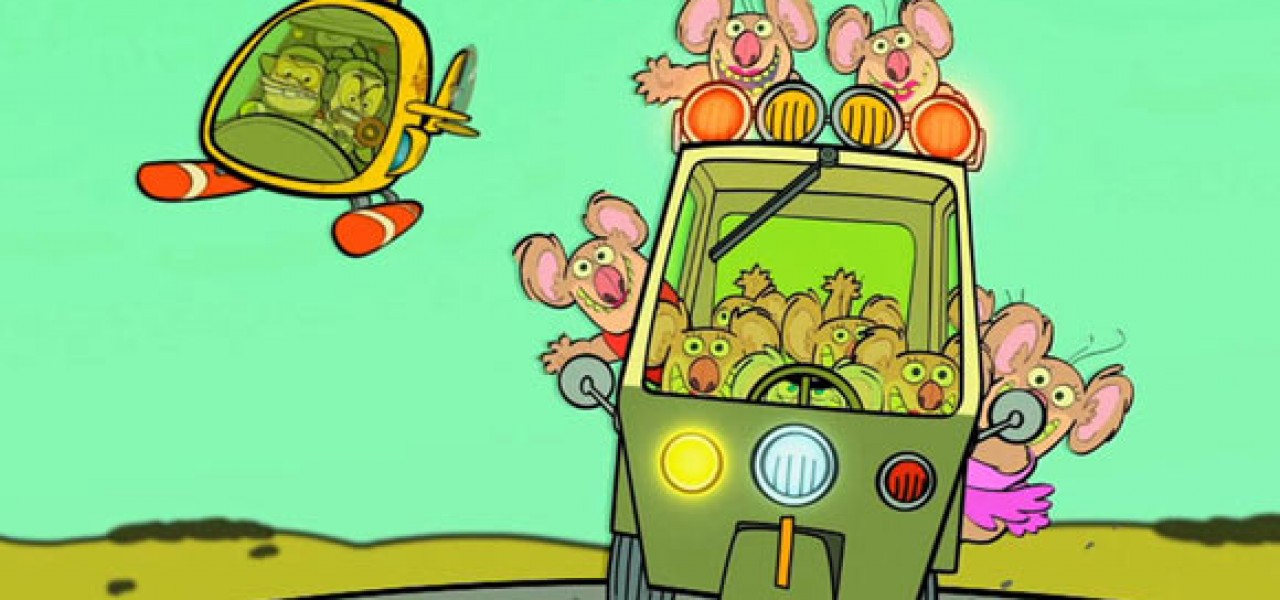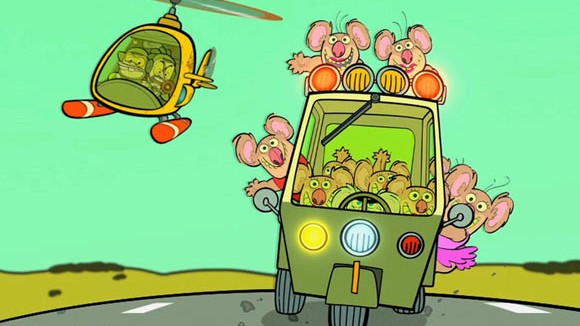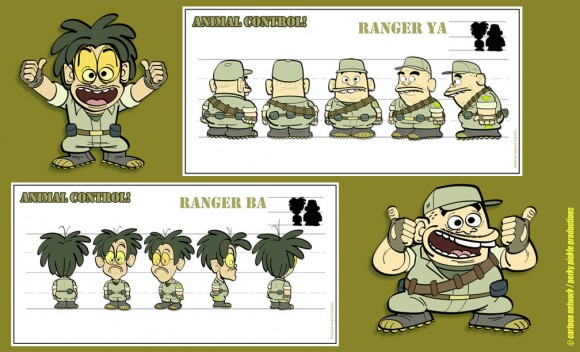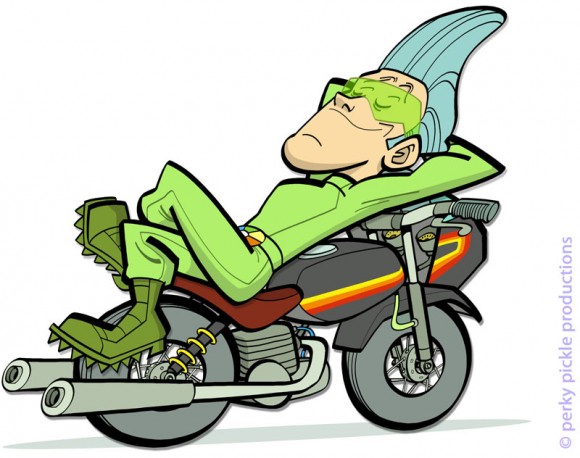

Jordan Reichek Talks about His New Shorts Series “Animal Control!”

Jordan Reickek is not a household name, and he prefers to keep it that way. When asked to provide a photo of himself for this piece, he questioned why it was necessary. He could care less about self-promotion; the real goal is to create cartoons of which he can be proud.
He’s spent a long portion of his career working in development, but he’s also been involved with plenty of projects that have made it to the public, including working on the original Ren & Stimpy series and the early years of The Simpsons, directing the pilot of Invader Zim at Nickelodeon, storyboarding on DreamWorks films like Monsters vs Aliens, Megamind and the Kung Fu Panda series, and working with major art world figures Kenny Scharf and Robert Williams to translate their ideas into animation.
For the time that I’ve known him, which has been over a decade, Jordan has always been working on something interesting and different. Recently, he’s been exploring a unique action-oriented, unabashedly cartoony style, and he recently applied this look to a series of animated shorts, Animal Control!, produced for Cartoon Network Asia. This week, he relaunched his production company website PerkyPickle.com which is filled with artwork from throughout his animation career. I interviewed Jordan via email about Animal Control!, his career so far, and where he wants to go with his work.

Cartoon Brew: You started working in the business in the early-1990s, but a lot of people aren’t familiar with your work. Tell me a little about your background.
Jordan Reichek: I sort of fell into animation. I was majoring in film at schools such as Pratt, NYU and USC. Not finding what I wanted there, I sought out CalArts and was admitted by Bob Winquist through his school, character animation. My intention was to eventually transfer into the live action program there. Kinda sneaky! I didn’t really draw too much at that point, but when I saw what other students like Pete Docter and Ash Brannon were doing for student films, I was hooked. I dropped live action and stayed in animation. I worked hard and had weird tastes for the time. I loved Hanna-Barbera and UPA when the school was leaning towards Don Bluth and the Disney revival of the ’90s. Eventually, I met John K. while he was starting up the pilot on Ren & Stimpy. It was right up my alley! John and I became pretty good friends and he convinced me to leave school and come work for him. It wasn’t a hard choice.
Since then, I’ve spent a lot of my career in development. It’s a part of the animation business that doesn’t get too much light shone upon it. I’d say for every show that gets picked up, there’s twenty that don’t. Circumstances for choosing those shows varies…a lot! Starting from a blank page is the hardest thing to do in animation….to bring a show from Post-it note idea, to blueprint, to production and then to the screen. It’s a painful yet amazingly fun process that I’ve done a lot of.
Cartoon Brew: You mentioned that you started working on the original Ren & Stimpy. You also spent time working on some of the early years of The Simpsons. How did those experiences inform your career?
Jordan Reichek: I actually got a job on the first season (yipes!) of The Simpsons while I was helping on the Ren & Stimpy pilot. Springfield during the day, Log at night! There’s no question your first jobs are the most influential…it’s the incubator for how you operate in the business later. For students, I think the first jobs are super important…soak in as much info as you can. Because John K. is such zealot for the fundamentals, we all were lucky enough to get a first class education from him on the job. I’d say it took a while to sink in though!
Repetition is the key to learning in this field. John taught that. I also remember an excerpt from the Illusion of Life, where Freddy Moore had a scene checklist that he’d pin right above his animation disc—a list of basic fundamentals to make sure every scene had. At first it seems obvious, but then you realize you have to FORCE the fundamentals into being second nature. I forgot the quote, but Chuck Jones also said something like you’ll do 100,000 bad drawings before you’ll do a good one. Those are good things for any student to remember…you can’t cheat repetition, you just gotta do it.
Cartoon Brew: Your latest project is Animal Control! It’s an unconventional format—dialogue-less shorts that are a couple minutes each. How did the project come about?
Jordan Reichek: Animal Control! came about from the redevelopment of an existing property for Cartoon Network Asia. There are actually several, centralized Cartoon Networks around the globe, each tailoring its version of the Cartoon Network signature content for their specific regions. The Hong Kong based network asked me initially to redevelop their existing property about a zoo, but eventually, we decided to start over with a new property based on my style. Rather than center on funny animals as central characters, we chose to center the stories on two animal reserve rangers…kinda like the Crocodile Hunter, but dumber. Although this was supposed to be a pilot, we thought the show would be more interesting to work as several 1-1/2 minute interstitials. Because I have already done some development based on Asian characters, I liked the idea of making the show very “Asian-centric.”
Cartoon Network Asia’s distribution influence is huge, covering most of the Asia Pacific but also a lot of other non-US countries around the globe. Since quasi-silent comedy such as Tom & Jerry do so well in non-English speaking countries, the network asked if I could write the show for minimal dialogue. Scary at first, it became a nice challenge to get away with non-verbal dialogue that featured lots of emotional expression. [See all the Animal Control! shorts at the Perky Pickle website.]

Cartoon Brew: Will Cartoon Network Asia air these Animal Control shorts or were they intended as internal studio pilots?
Jordan Reichek: This was intended as simply a pilot. After discussing with network management, we agreed that although a lot more work, doing ten ‘little stories’ would be more effective to introduce the characters and the world. Apparently, the international Cartoon Network affiliates have a more liberal broadcast structure than in the US. They thought the interstitial route could work well as an intro to their viewers. I tried to tell a different part of the story with each short, something that would have been difficult with one linear pilot.

Cartoon Brew: The visual style you used on Animal Control was rooted in a show you developed a few years ago based on the Japanese live-action show Robocon. It’s a distinctive and fun look that mixes together Western and Eastern influences without being derivative of any specific style. Can you talk about how this look evolved?
Jordan Reichek: I was asked to do some development for Cartoon Network Japan awhile back on some of their asset properties. We chose Robocon, the 1970s live action kid show with the rubber suited robot, which was owned by Itochu, the parent company. I was given carte blanche to make whatever I wanted with the property for a Japan/US co-production. Not wanting to be tied to the original live action Robocon but still appeal to both the US and Japanese audiences, I had the show take place in Japan with Japanese characters. I kinda hate when foreign properties are re-worked to be American. I also love when other countries do their take on Americans, so why not have an American do their impression of Japan? Accurate? Probably not, but that’s kind of the point! It’s like an animated Paul Verhoeven film…probably way off culturally, but still fun to see his weird impression!
The style is an amalgamation of my work over the years. It’s got roots in Japanese and French comics, but also the expressive emotional nature of where I started with Ren & Stimpy. John K. taught the purity of specific drawn emotion over stock or generic acting. In the case of Animal Control!, I wanted Rangers Ya and Ba to be to funny jerks with real personalities you’d love to hang out with. In my opinion , that takes organic acting. My design style hopefully affords that.
All these shows that are variations on a unified world I’m creating. Think of Matt Groening’s style…everything he does from The Simpsons to Futurama seems like it comes from the same Simpsons god. Hanna-Barbera was sorta like that. I want my shows, no matter what form they take, to appear as if they can co-exist in the same space. The world of Animal Control! can easily exist in the same city as Rainbow Riders! or Robocon.

Cartoon Brew: You’ve been really good at working with artists from outside of animation and adapting their art and ideas to animation—the comics of Jhonen Vasquez, the fine art of Kenny Scharf, the world of painter Robert Williams. Do you seek out these type of collaborations or do they come to you?
Jordan Reichek: In all those cases, I was approached to work with the individual artists. Not all artists are the same and not all work easily in the collaboratively necessitative world of animation production…some are more open than others. I have tried to make sure to not overstep the artistic boundary of interpreting into animation what the artist wanted. Sometimes that’s easier said than done! The key is finding a middle-ground of what can be achieved in a commercial production process as opposed to a one-shot boutique project. The next hurdle is convincing the artist and getting them involved in that process. I have really enjoyed doing that.

Cartoon Brew: What elements are missing in animation nowadays that you want to bring to it?
Jordan Reichek: Well, things are really picking up now. There’s some terrific, ground-breaking shows like Adventure Time that make you realize the potential of animation. I think there’s a BIG NEED for individual voices. I think the gap between what is adult and what is ‘children’s animation’ needs to be less defined. I know I have been tailoring my work to hopefully fill a void in the content basket that is out there. I believe now more than ever, specific, individualized points of view will connect best with audiences. My work is starting to reflect that. At first, I avoided being pigeon-holed. If you see my work on my site, it’s varied. Now, I want to begin to explore my personal voice. Kids have always been pretty advanced in their tastes and now, with kids who are constantly connected, they sniff out authenticity more than ever. I would like to see more people in animation recognized for their potential and given a chance even when they aren’t the squeakiest wheel.

Cartoon Brew: What you’re planning to do next? And can you tell us anything about something that I’m personally looking forward to—Rainbow Riders?
Jordan Reichek: I actually have a lot of different shows with varied themes that are in planning. Rainbow Riders! is the first one out of the gate. It’s a culmination of what I’ve been working on the past few years. I love doing slapstick comedy but I also love fast vehicular action. The Animal Control! short “Joy Ride!” is a taste of that. Again, the show is set in a non-defined Asian setting…a fictitious city of the near future a la EPCOT. A lot of my interests in Japanese comics and live action tokusatsu will be melded with comedic characters and situations. I have such love for Shotaro Ishinomori’s work and after working with his family on the reboot of Robocon, that got solidified. The characters and their stories in this one have a good amount of depth and the situation gives the whole story a great backbone. If you love MONSTER, MOTORCYCLES and MORONS, you’ll love Rainbow Riders!

.png)